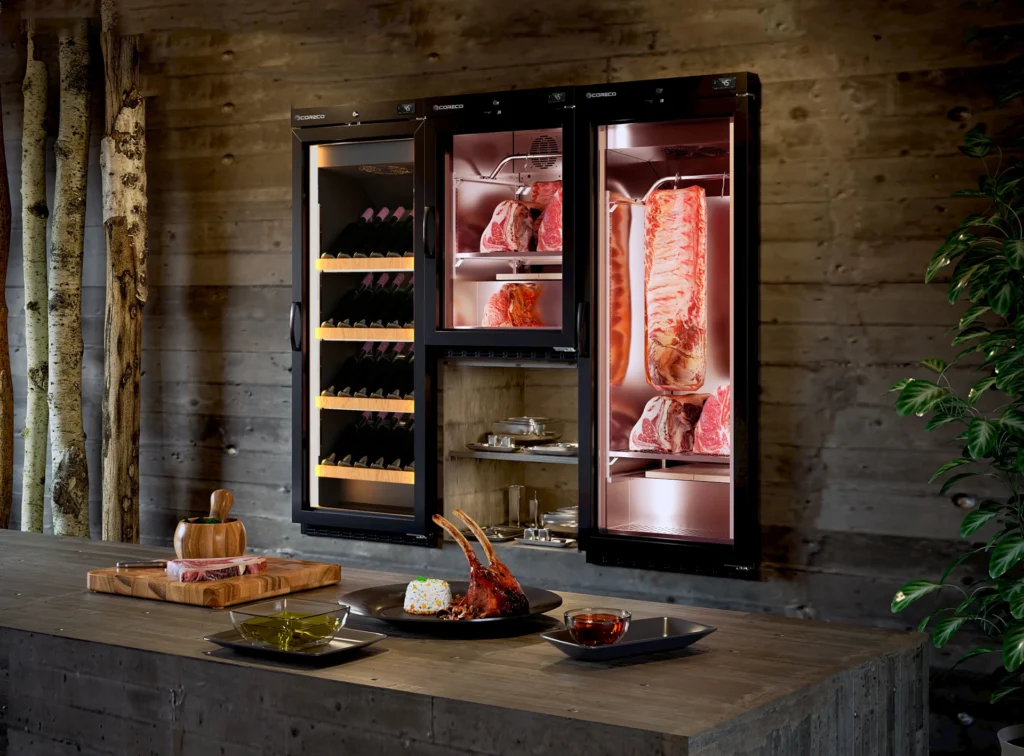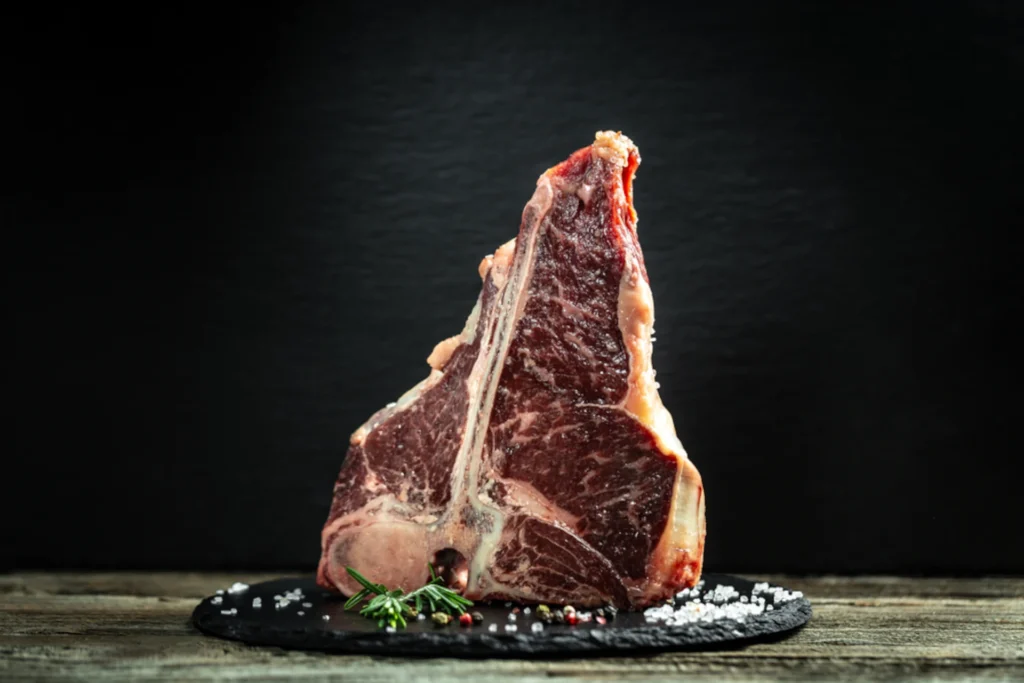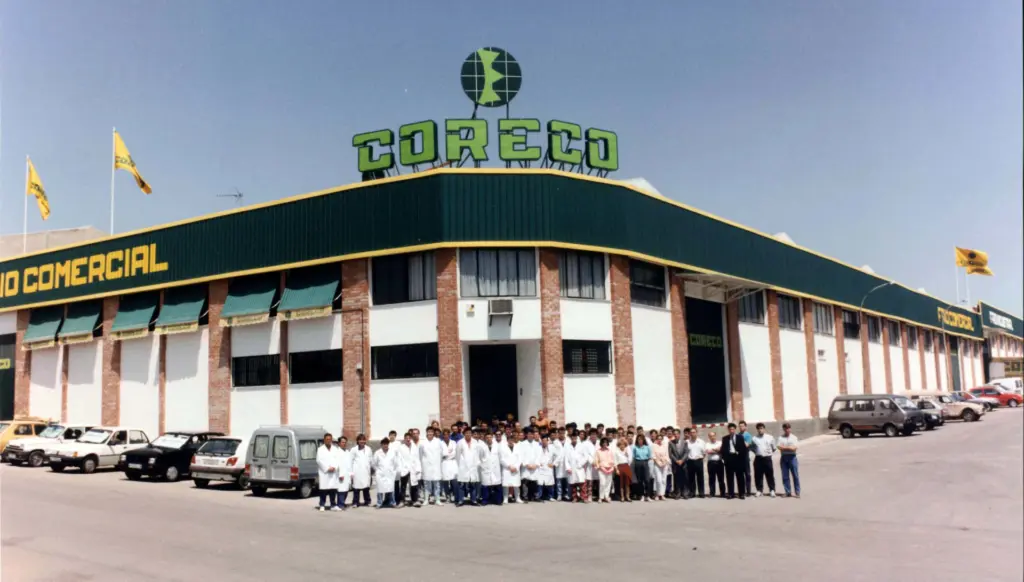The Dry Aged matured meat in a restaurant has become a hallmark for venues seeking to offer a superior dining experience. But it is not enough to have the best product: you need control, technology and a presentation concept that combines technical precision and commercial appeal.
Opening or renovating a restaurant specialising in Dry Aged matured meats means much more than having good cuts of meat or a qualified chef. It means committing to a gastronomic concept that requires technical precision, aesthetic coherence and professional equipment. Dry Aged maturation is a complex process that transforms the meat into a sensory experience, and to achieve it with guarantees, a controlled environment is required that only the specialised industrial refrigeration.
In this article you will find a complete guide on what equipment your restaurant needs to work correctly with matured meat. You will see real examples in Europe, learn about the technical parameters necessary for safe maturation, the keys to profitability of the model and, above all, how to present the process as part of the restaurant's storytelling. Coreco Gourmet offers solutions specifically designed for this sector, combining design, sustainability, efficiency and precision.
Why is Dry Aged matured meat a profitable bet in catering?
More and more gourmet restaurants are incorporating Dry Aged matured meat in their menus. Why? Because customers value exclusivity and are willing to pay more for a product with identity, history and process. Dry Aged meat is not only tasted: it is contemplated, chosen judiciously and remembered. This effect raises the average ticket naturally, without resorting to forced price increases.
Betting on including Dry Aged matured meat in a restaurant not only allows us to differentiate ourselves, but also to raise the average ticket, capture a demanding customer and build customer loyalty through an experience that begins long before the dish.
In addition, working with matured meat positions the restaurant at a higher level. Not everyone has the technical capacity or the knowledge to offer it in optimal conditions. Incorporating a visible maturing cabinet in the dining room, with a menu that explains the process and the origin of each piece, transforms a dish into a brand story. This differentiation translates into reputation, loyalty and sustained business growth.
High value perception = higher average ticket
Differentiation from traditional competition
Loyalty of the customer looking for experience and product
What industrial refrigeration do you need to mature meat in your restaurant?
Matured meat needs very specific conditions to develop its organoleptic qualities without compromising food safety. For this reason, not just any cold room or display cabinet will do. You need Dry Aged maturation cabinetssuch as the Coreco Gourmet DAV-400 or DAW-400 models, designed exclusively for this purpose.
These cabinets precisely control the four key process parameters: temperature (0°C to 4°C), humidity (75-85 %), continuous ventilation and time. In addition, they incorporate technology such as the Master Ageing Controllerwhich reduces evaporation loss to less than 10 %, which is essential for cost-effectiveness. Compared to industrial chambers, these cabinets have a lower energy consumption, are quiet and, above all, can be used in a wide range of applications. be located in visible areas of the restaurantIt has become a sales tool and not just a conservation tool.
Incorporating a maturation cabinet is a must if you want to work with Dry Aged matured meat in a restaurant safely, visibly and cost-effectively, while complying with all quality and sustainability standards.
Dry Aged maturation cabinets: technical keys
- High-density thermal insulation
- Energy efficient inverter compressors
- Optimised and homogeneous air flow
- LED lighting that enhances the product
- AISI 304 stainless steel finishes
In-room visibility: turning the wardrobe into a marketing tool
Coreco Dry Aged enclosures are designed not only to perform, but also to seduce. Glazed doors with inert gas and low-emission treatment allow a clear view of the product without fogging. The illuminated interior with specific LEDs turns each piece into an edible sculpture. This visibility transforms the ripening process into a visual experience that attracts, communicates value and generates desire.
Including the cabinet in the room not only optimises space: it makes the meat the star of the show before it reaches the plate. This reinforces the perception of exclusivity and allows the customer to understand the reason for the price, even without the waiter having to explain it.
Real-life examples from restaurants in Spain, France and Germany
At Valenciaan urban steakhouse decided to integrate a DAV-400 cabinet visible from the main room. The visibility of the product, coupled with explanations from the staff, led to a 22 % increase in matured meat orders in just six months.
At Lyona modern brasserie placed a DAW-400 cabinet next to the entrance of the restaurant as part of the decorative concept. Result: increased foot traffic, more positive reviews on platforms such as Tripadvisor and better local SEO positioning thanks to mentions of their "meat cellar".
At BerlinThe new Coreco meat display cabinets and a refrigerated wine cellar were integrated into an open-kitchen steakhouse. The result was a complete wine pairing experience, increased bottle rotation and a clear brand identity: "the temple of maturation".
These examples show how good integration of Dry Aged matured meat in a restaurant not only improves the menu, but also generates conversation, attracts customers and improves the venue's online reputation.
Recommended equipment according to your type of kitchen
Each type of restaurant has its own needs. In a traditional steakhouse, the cabinet can be placed in a passageway as an impact element. In fine dining, it can be integrated with a refrigerated wine cellar. And in a mixed or tapas kitchen, compact formats guarantee flexibility without sacrificing performance.



Recommended equipment according to your type of kitchen
The choice of professional equipment depends on the type of kitchen and the gastronomic focus of your restaurant. Below are the key recommendations for three common profiles, along with the most appropriate approach to use:
| Type of restaurant | Key teams | Recommended approach |
|---|---|---|
| Traditional grill or barbecue | Dry Aged Cabinet DAV-400 or DAV-600 | Frontal exposure in the passageway area to highlight meats |
| Fine dining restaurant | DAW-400 + wine cellar Coreco | Maturation and conservation as part of the experience |
| Mixed cuisine (meats and tapas) | DAV-400 + conservative GN | Compact format, high turnover and versatility |
Traditional grill or barbecue
- Essential equipment:
- Meat maturation cabinet (Dry Aged DAV-400 or DAV-600) to enhance the quality and ageing of cuts.
- Professional grills, griddles and accessories such as brackets, goat, charcoal shovel and skewers to optimise the cooking and presentation of meats.
- Extractor hood to keep the environment smoke-free2.
- Recommended approach:
- Place the ripening cabinet in an area visible to the customer, as part of the experience and transparency of product quality.
Fine dining restaurant
- Essential equipment:
- Maturation cabinet DAW-400 for premium meats.
- Professional wine cellar (e.g. Coreco) for high-end wine pairings.
- Specialised equipment such as vacuum packing machines for modern techniques (sous vide, quick marinades).
- High-performance, low-noise blenders for sauces and creams without affecting the environment.
- Recommended approach:
- Integrate maturation and preservation into the customer experience, showcasing the process and the selection of exclusive products.
Mixed cuisine (meats and tapas)
- Essential equipment:
- Compact ripening cabinet (DAV-400) to optimise space.
- GN preservative to keep ingredients fresh and ready for high rotation.
- Combi ovens (convection + steam) for versatility in the preparation of meat, tapas and other dishes.
- Griddles and fry tops for a variety of cooking techniques.
- Recommended approach:
- Prioritise multifunction and small equipment to suit kitchens with limited space and varied menus.
General considerations for any type of kitchen
- Refrigeration and storage: Industrial refrigerators, freezers and storage cabinets are indispensable to maintain the quality of the ingredients.
- Cooking: Cookers, professional ovens, griddles and grills adapted to the volume and type of kitchen.
- Preparation: Stainless steel work tables, professional cutlery, blenders and mixers.
- Ventilation: Extractor fans and air purification systems to comply with regulations and ensure comfort.
- Cleanliness: Automatic dishwashers to maintain efficiency and hygiene at all times.
How much does it really cost to mature meat in the meat room?
Suppose you buy a 10 kg piece of meat at €15/kg. If the maturation process is well controlled, the shrinkage will be less than 10 %, and you will be able to sell it in portions at €60/kg or even more. That is a net profitability above 200 % per piece, not to mention the added value it generates in terms of charter and reputation.
In addition to this, Coreco enclosures consume up to 55 % minus than conventional systems. This is achieved with inverter technology, energy-saving LEDs and efficient insulation. Every euro invested in the equipment is recouped not only with meat, but also with operational efficiency.
Sustainability and regulations: keys to restaurant design
Every modern restaurant must comply with the regulation F-Gas 2024which regulates the use of refrigerant gases. Coreco works with R290a natural refrigerant that does not damage the ozone layer and has virtually zero climate impact.
In addition, the integration of systems Digital HACCP and the low noise level of the equipment allow for a free and visible installation, without compromising the room experience. This complies with the law, cares for the planet and projects an image of responsibility that customers value.
📌 See our complete guide to F-Gas regulations
How to present matured meat on the menu and in the dining room
Matured meat needs to be counted. Its value is not only in the taste, but in the time, the method and the wait. Including information on the menu about the type of cut, the maturation time, the Dry Aged method and the origin of the piece allows the customer to understand what they are paying for and to enjoy what they are eating more.
In addition, you can associate matured meat with pairing proposals, tasting menus or even vertical tastings. This not only increases the average consumption per diner, but also turns your restaurant into a place of experiences, not just dishes.
Ideal product flow in a Dry Aged restaurant
📍 Elements to be included in the visual version:
- Receipt of the product → Initial sanitary control and preservation
- Maturation in a specialised cabinet (DAV-400, DAW-400)
- Cutting in front of the customer (display area or open kitchen)
- Room service
- Feedback for process adjustments
Each stage can be supported by adapted and connected Coreco equipment to ensure quality and traceability.
How to sell Dry Aged maturation cabinets to existing and new restaurants
Distributors and Horeca consultants play a key role. The Dry Aged cabinet must be presented to a restaurant that is already open as a natural evolution of its proposalImprove your charter, your image and your profitability. Showing real cases, providing average ticket data and guaranteeing fast installation is key.
In the case of new projects, the Dry Aged should enter from the design of the premisesas a conceptual pillar. "Here we mature our meat on sight" can be the claim that defines the whole restaurant experience. You have to sell the value, not the equipment. The cabinet is just the tool.
The meat is matured with precision, but the concept is sold with vision.
A restaurant specialising in Dry Aged meats needs much more than product: it needs technology, narrative and strategy. Choosing the right equipment is a technical decision, but also a statement of intent. At Coreco Gourmet, we design solutions that combine professional cooling, energy efficiency and commercial attractiveness.

The phrase "The meat is matured with precision, but the concept is sold with vision" sums up the essential duality in the matured meat business: technical excellence in the process and the importance of an appealing narrative for the customer.
Precision maturation
Meat maturation is a highly technical process that requires rigorous control of parameters such as temperature, humidity, ventilation and time. Advanced equipment, such as maturation controllers, allow these factors to be precisely adjusted, optimising water loss (shrinkage) and ensuring a more tender texture and more intense flavour. For example, technologies such as the Master Ageing Controller reduce shrink to less than 10%, compared to the usual 15-20%, maximising profitability and ensuring superior quality cuts. In addition, real-time monitoring and predictive microbiological models ensure food safety and product consistency.
The concept is sold with vision
However, the commercial success of matured meat does not depend on technical precision alone. The perception and value that the customer attaches to these products is built through experience and storytelling. Matured meat has become a cultural and gastronomic phenomenon, where the visual display of the maturation cabinets, the explanation of the process and the presentation on the menu are key to justify its price and exclusivity. Restaurants and gourmet butchers highlight the story behind each cut, the maturation time and the selection of animals, turning the purchase or consumption into a differentiated and memorable experience.
"Meat maturation has not only been a technical process, but also a cultural phenomenon".
In short, precise maturation makes for an excellent product, but it is the vision - how that process and its results are communicated and presented - that makes matured meat a desired and valued product for the consumer.
Don't just ripen meat. Mature your gastronomic proposal with tools that elevate your concept. and project it with strength, flavour and sustainability.
Coreco, an experienced manufacturer
Are you designing a restaurant specialising in Dry Aged matured meat?
Let's talk about how to equip it with precision, sustainability and design.
➡️ Request personalised technical advice
If you want your proposition to stand out in a competitive gourmet market, working with Dry Aged matured meat in a restaurant will be one of the most strategic decisions, both gastronomically and commercially.









